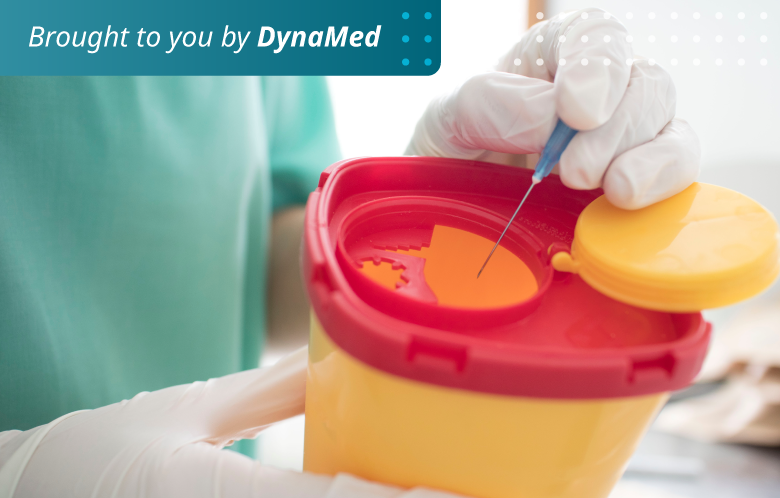You are working a busy shift in clinic and have successfully completed a blood draw on your patient, a notoriously difficult stick, and when you reach over to grab some gauze and a dressing you feel a sharp stab. You look down and see the needle sticking into your hand. How could you have forgotten to properly dispose of your sharp? What do you know about this patient? Could they have HIV, or something else? Several questions arise as you try to process what to do next.
Is this a familiar situation to you? It certainly is for the estimated 385,000 healthcare workers who report a needlestick and sharps injury in the United States each year. Globally, there is an estimated 45 percent annual prevalence of occupational needlestick injuries in healthcare workers. Experienced healthcare professional or not, a needlestick or sharps injury can take anyone by surprise.
Here is what to do if this happens to you or if you are a clinician caring for an individual with a sharps injury:
- The immediate first step is to care for the site of injury. Needlestick or sharps injuries should be washed with mild soap and clean water for 15 minutes, and direct pressure should be applied to wounds to control bleeding.
- Next, evaluate the exposure. A true exposure that carries a risk of infection involves both the presence of potentially infectious body fluid (such as blood) and a portal of entry. An example is a subcutaneous puncture wound from a used hollow-bore needle that previously drew blood from a source patient.
Following a careful examination, immediately report the exposure to occupational health. If possible, gather information on the source person such as HIV status. There is consensus among the clinical body of evidence that HIV that is undetectable due to an individual taking antiretroviral therapy as prescribed is untransmissible sexually (a concept known as U=U), though the evidence on transmission is not as robust for needlestick and sharps injuries.
While there are many potentially transmissible bloodborne pathogens a healthcare worker could encounter, HIV and hepatitis B and C viruses are the most relevant and commonly encountered from a needlestick and sharps injury. Testing of both source person and exposed person for these three pathogens is advised, if possible.
- Determine the need for post-exposure prophylaxis (PEP) according to the level and timing of exposure and the personal preferences of the exposed person. For a higher risk exposure addressed within 72 hours, such as a percutaneous sharps injury where the source person is HIV positive, HIV PEP is typically recommended for the exposed person. Immunization records of the exposed person should also be reviewed in addition to antigen and antibody testing to determine whether hepatitis B PEP is needed. There is currently no PEP recommendation for hepatitis C following an occupational exposure.
Counseling is vital as needlestick and sharps injuries can be anxiety-provoking for exposed individuals. It is important to manage these cases in a person-centered manner that both outlines known data on transmission (such as the low documented 0.23% risk of transmission of HIV when a source person is HIV positive) and respects the exposed person’s wishes for PEP, if they choose it. HIV PEP should not be denied if the exposed person requests it.
-
Arrange for follow-up testing for the exposed person. If the exposed person took HIV PEP, evaluate and monitor them for drug toxicity for a minimum of two weeks. Regardless of whether the exposed person took HIV PEP or not, HIV antibody testing at approximately six weeks, three months, and six months should be carried out.
Follow-up after potential hepatitis B exposure is only needed if an HBV vaccine is given as PEP. Test for anti-HBV surface antibodies in the exposed person one to two months following the final vaccine dose.
Hepatitis C follow-up involves testing for hepatitis C RNA at four to six weeks if an earlier diagnosis is sought, and anti-HCV antibody testing and measurement of alanine aminotransferase levels at four to six months.
It is well worth mentioning that an ounce of prevention is worth a pound of cure when it comes to needlestick and sharps injuries. There are many strategies that can be implemented to better protect healthcare workers from occupational sharps injuries, including safety-engineered sharps devices (such as retractable sheathed needles), proper sharps disposal systems, and healthcare worker education on handling and disposing sharps safely. Ensuring that healthcare workers have routine immunizations, such as for hepatitis B, is also important to avoid some occupational diseases.



